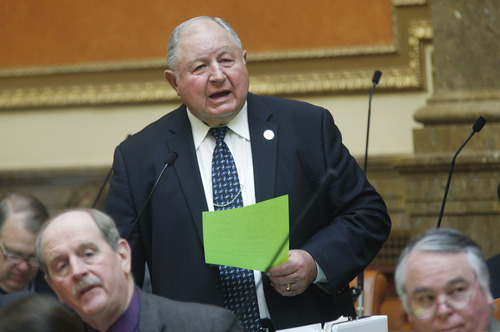This is an archived article that was published on sltrib.com in 2013, and information in the article may be outdated. It is provided only for personal research purposes and may not be reprinted.
The looming threat of automatic federal budget cuts due to kick in at week's end would hurt Utah's economy and state tax revenues, forcing legislators to tighten their belts a notch or two.
Legislators had anticipated having $300 million in new revenues to use to build a state budget. But on Monday, those figures were scaled back by more than 10 percent, with $264 million in growth now forecast.
Still, said House Speaker Becky Lockhart, R-Provo, leaders were fearful that the numbers would take a bigger hit.
"I was very pleased. It could have been much worse," Lockhart said. "It's an indication that the Utah economy is doing quite well and able to overcome some of the impacts of the federal policies on the state."
By week's end, $85 billion in automatic federal budget cuts are due to start unless Congress can reach a deal to avert the so-called sequester. The cuts are expected to leave a $39 million hole in various state programs, which leaders said would be filled on a case-by-case basis.
The revenue projections were also lowered as a result of federal tax increases that kicked in at the beginning of the year.
"I don't know if there's been a more difficult year to put together figures," said Senate budget chairman Lyle Hillyard, R-Logan.
House budget chairman Mel Brown, R-Coalville, said fiscal analysts also anticipate a "psychological impact" as a result of the budget cuts and tax shifts that "will have some kind of impact on the budget, but we can't tell what it is."
Brown also said the state will not know for months what the overall effect of sequestration may be on Utah. He said lawmakers may have to come back later to address it, "or not," depending on what happens.
Gov. Gary Herbert said that the figures show that the state's economic fundamentals are strong but "Washington, D.C., is having a chilling effect on our state's recovery."
"We would be seeing even greater growth were it not for the backdrop of federal uncertainty and a fragile national economic recovery," said Herbert, who reiterated that education remains his top priority.
Meeting the education needs could absorb much of the new revenue.
Utah's public schools are seeking $130 million in the coming year — which includes $75 million to maintain the current last-in-the-nation per-pupil funding in the face of 12,500 new students enrolling in the fall, and to cover a $25 million accounting error.
In addition, state health care and retirement rate increases could cost $80 million and catching up on postponed building maintenance is projected to cost $55 million. Another $19 million is being sought to rent cell space in county jails to incarcerate state prison inmates.
But Rep. Tim Cosgrove, D-Murray, said that if Utahns sincerely want to adequately fund public education, then there needs to be an honest discussion about how to come up with the money.
"We have to put our money where our mouth is and where is that money going to come from if our economy isn't growing at a [sufficient] rate?" asked Cosgrove.
He said there are other needs as well — including a domestic violence shelter in Ogden that has a waiting list, expanding primary care and other social service priorities.
Lockhart said the Legislature will balance the budget with the money it has because there is no willingness among House Republicans to raise taxes this year.
"It has to be enough," she said. "The families and people of Utah, when they want more money, can't go out and take it from their neighbors and as a government we ought to learn to live within our means, as well."
Utahns selling off assets at the end of 2012 to avoid higher tax rates that were to kick in at the beginning of the year helped bring an additional $40 million, bringing to $161 million the one-time money available — funds that won't be collected again next year.
Juliette Tennert, Herbert's chief economist, said a resurgence in residential building permits also contributed to a spike in one-time funding.
The $264 million in ongoing revenues and $161 million in one-time money is more robust growth than the state has seen in years, and Utah's economy is expected to continue an upward trajectory, according to the economic assumptions released by the State of Utah Revenue Assumptions Working Group last week.
Notably, the forecast sees the state's unemployment rate falling to 4.8 percent and personal income is projected to grow by 5.9 percent.
But they could have been even better. For example, Tennert said, wages were expected to grow at 6.7 percent in the coming year, but that was scaled back to 6.1 percent because of the impending sequestration.
The economic forecast and the new revenue projections both assume that Congress will strike a deal in the coming months to replace across-the-board cuts of the sequester with more targeted reductions.
Twitter: @RobertGehrke
Tribune reporter Lee Davidson contributed to this story. —
What's next?
• Legislative leaders will meet Wednesday and adopt the new revenue figures.
• Budget subcommittees will decide their top funding priorities and make recommendations back to the full budget committee.
• Legislators have to take action to pass the final budget by March 14 at midnight — the constitutionally mandated end of the session.





